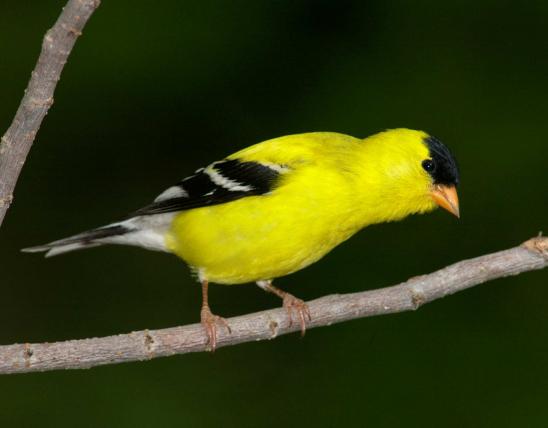
Evening grosbeak male upperparts are yellow, with black wings and tail and a brownish wash on the head and back; the white secondary feathers create a large white patch on the wing. The forehead and eyebrow are yellow. The large, conical bill is ivory. Underparts are yellow, with a brownish wash on the throat and upper breast. In females, the upperparts are grayish tan, with black wings and tail; the wing has a white patch at the base of the primaries, the secondaries are white, and there is a white tip to the tail feathers. The neck collar is yellow. Underparts are grayish yellow. Song is a hesitant warble, not often heard in Missouri. Call is a short, harsh peeer given frequently in flight.
Similar species: American goldfinches are much smaller (sparrow-sized), while evening grosbeaks are sized like a chunky robin with a relatively short tail. Because evening grosbeaks usually appear in flocks in Missouri, you usually see several males and females appearing together.
Length: 8 inches (tip of bill to tip of tail).
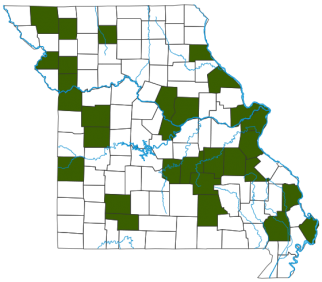
Statewide.
Habitat and Conservation
Rare winter resident foraging for seeds, insects, buds, and fruits in woodlands (especially those with box elders), in shrubby areas, in backyards, and in and around conifers. It is sporadically present in Missouri, depending on flocks wandering into the state. It frequently visits birdfeeders for sunflower seeds.
Food
When most Missourians see evening grosbeaks, the birds are at birdfeeders devouring sunflower seeds. They eat many other seeds and fruits, including box elder and maple, ash, and tulip poplar seeds, plus cherry, apple, crabapple, hawthorn, and juniper fruits. They come to Missouri in winter in years when pinecone seeds, farther north, are insufficient for their numbers. During the breeding season, they switch to insects, which provide extra protein for their nestlings.
Status
As a winter resident, rare and sporadic. Accidental summer visitor (nonbreeding).
Life Cycle
Evening grosbeaks primarily live in northern North America and in the high elevations of the Rocky Mountains, where they breed in coniferous forests. In years where pine seeds are not abundant, many of these birds “irrupt” (suddenly expand their range) south- and eastward during the winter. Because they travel in flocks, the sudden, unexpected appearance of these large, attractive birds at wintertime birdfeeders in Missouri creates a local sensation.
Human Connections
In the early 1900s, evening grosbeaks expanded their range into the Northeast, apparently in part because people had planted lots of box elders in that region. Box elders provide evening grosbeaks a source of wintertime seed.
Today, logging and spraying for insect pests may be reducing available habitat and food in their breeding territory.
Ecosystem Connections
Many of the insects eaten during breeding season are serious pests. For example, this grosbeak and some other birds play an important role in preventing large outbreaks of spruce budworm. Large outbreaks of that insect can defoliate acres of balsam firs, spruces, pines, and other conifers.


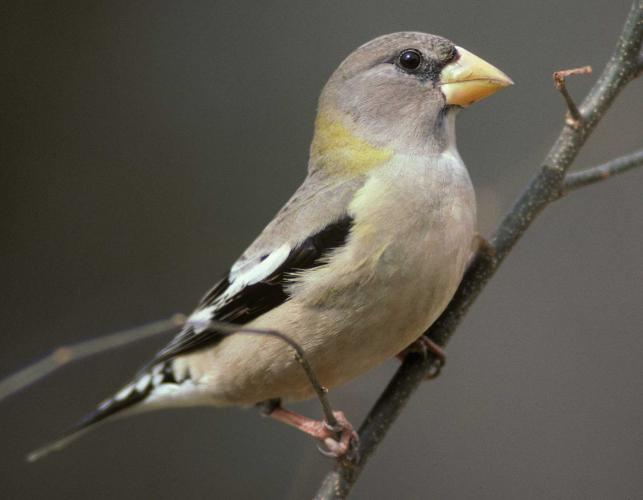

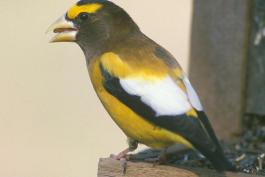


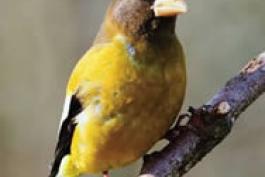
About 350 species of birds are likely to be seen in Missouri, though nearly 400 have been recorded within our borders. Most people know a bird when they see one — it has feathers, wings, and a bill. Birds are warm-blooded, and most species can fly. Many migrate hundreds or thousands of miles. Birds lay hard-shelled eggs (often in a nest), and the parents care for the young. Many communicate with songs and calls.






















